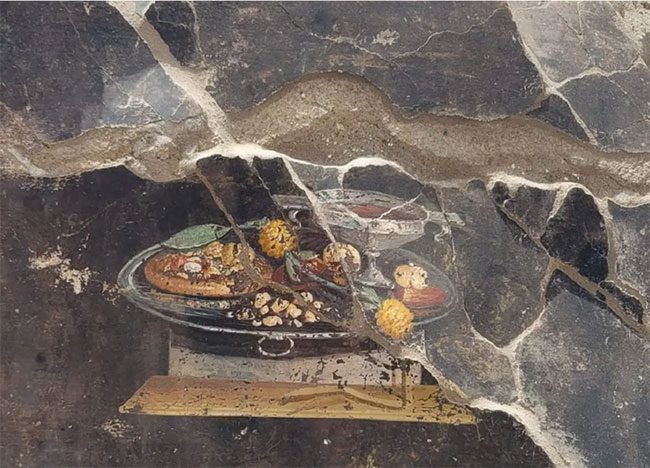Another “timeless” discovery has astonished the archaeological team working in Pompeii, the Roman city buried 2,000 years ago under volcanic ash.
According to Heritage Daily, during excavations in the luxurious Regio IX area of Pompeii, the team uncovered a walls painting depicting an ancient dining setup in good condition.
From an archaeological perspective, a nearly intact and vivid painting after 2,000 years is already a significant treasure, but what’s more shocking is that on the dining table depicted, there is the presence of… a pizza.

A lavishly presented banquet on a silver plate, featuring some rustic dishes of ancient Greek-Roman cuisine, including… a pizza-like dish – (Photo: POMPEII ARCHAEOLOGICAL PARK)
It does not resemble the “traditional” pizza but rather a variant that aligns more closely with the styles that people from different countries have created in recent years to suit local tastes and utilize local ingredients.
Nevertheless, the presence of this “ancestor” of pizza is entirely unexpected. Previously, it was believed that pizza was a modern fast food, although it has deep roots as a type of flatbread from Italy dating back 1,000 years.
However, the items in Pompeii are all dated at approximately 2,000 years or older, as the city was buried during the volcanic disaster of Vesuvius in 79 AD.
The pizza depicted in the mural may be even older, as per Gabriel Zuchtriegel, the Director of the Pompeii Archaeological Park, who stated that this fresco illustrates themes of Greek hospitality, a subject that the renowned Roman artists developed further.
The mural was discovered in an area that had begun excavation in the 19th century, located in the atrium of a house in Regio IX – the heart of Pompeii, now part of Italy.
The house is a large villa that collapsed, and nearby the painting, there is a large oven. The remains of three victims of the volcanic disaster were also found in the house.
This is not the first time Pompeii has revealed “timeless” elements. Previously, archaeologists were astonished to discover roads with repair techniques comparable to modern times, intricate architecture with amenities almost akin to the 21st century, and even a fast food “takeaway” stand in the city center.


















































